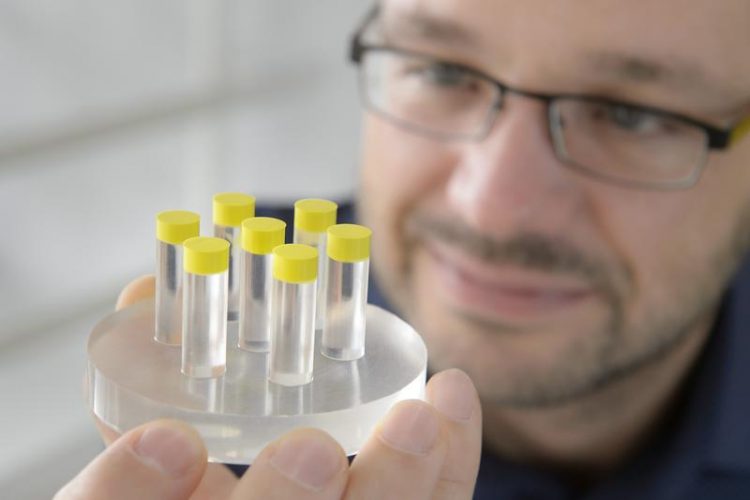Innovative combination of hard and soft materials improves adhesion to rough surfaces

The large-scale model shows basic principle and structure of the new adhesives, where soft materials (yellow) are applied to harder materials. Source: Iris Maurer; free within this press release
As a result, industrial handling processes can be improved and made safer, and that is not all. The materials are also promising in terms of on-skin applications, such as self-adhesive wound closures or “wearables” – networked computers that can be applied directly to the skin.
The scientists presented their findings in the renowned scientific journal Applied Materials &Interfaces. Co-author René Hensel is now going to receive the Adhesion Innovation Award in recognition of this publication. This award is co-organized by EURADH (European Adhesion Conference) and FEICA (Association of the European Adhesive & Sealant Industry).
As part of their investigations, the research scientists developed two-millimeter pillars as a model system and brought these into contact with rough surfaces. The measured force required to peel the pillar away again is the measure of the adhesion.
“The pillars that we used were made of a hard material but their ends had a layer of soft plastic. In order to peel away this pillar, we needed to apply a force that was five times greater compared to peeling away a pillar composed entirely of the soft material. Therefore, it clearly adheres better,” explains René Hensel, the Deputy Head of the Functional Microstructures program division.
The research scientists established during the investigations that the quality of adhesion corresponds to the softness and thinness of the coating applied to the ends of the pillars. The softer the material, the better its ability to adapt to rough surfaces. The fact that adhesive strength correlates to how thin the coating is goes hand in hand with the delayed formation of cracks during contact: The adhesive structure detaches from the surface whenever a crack forms.
These cracks take longer to form due to reduced stress peaks. As a result, cracks and detachment only occur under higher loads. “Surprisingly, the thinner the coating is, the more pronounced this phenomenon,” adds Hensel. Adhesion is also affected by the shape – how two materials of varying hardness are combined. A rounded boundary layer between both materials improves adhesion. This also appears to affect the formation of cracks.
The thickness of the soft coating should simultaneously match the degree of roughness: “The surface of woodchip wallpaper is far rougher than skin, for instance, so in order for something to adhere to woodchip wallpaper, a much thicker soft coating must be selected compared to adhesion to skin,” says Hensel. The research scientists are currently very interested in adhesion to skin. This is central to future research as it appears to play a particularly important role in the development of “wearables” as well as for treating wounds.
Your expert at INM:
Dr. René Hensel
Deputy Head Functional Microstructures
Phone: +49681-9300-390
rene.hensel@leibniz-inm.de
Sarah C. L. Fischer, Eduard Arzt, and René Hensel, „Composite Pillars with a Tunable Interface for Adhesion to Rough Substrates”, ACS Appl. Mater. Interfaces, 2017, 9 (1), pp 1036–1044, DOI: 10.1021/acsami.6b11642; https://pubs.acs.org/doi/10.1021/acsami.6b11642
Media Contact
More Information:
http://www.inm-gmbh.deAll latest news from the category: Materials Sciences
Materials management deals with the research, development, manufacturing and processing of raw and industrial materials. Key aspects here are biological and medical issues, which play an increasingly important role in this field.
innovations-report offers in-depth articles related to the development and application of materials and the structure and properties of new materials.
Newest articles

Silicon Carbide Innovation Alliance to drive industrial-scale semiconductor work
Known for its ability to withstand extreme environments and high voltages, silicon carbide (SiC) is a semiconducting material made up of silicon and carbon atoms arranged into crystals that is…

New SPECT/CT technique shows impressive biomarker identification
…offers increased access for prostate cancer patients. A novel SPECT/CT acquisition method can accurately detect radiopharmaceutical biodistribution in a convenient manner for prostate cancer patients, opening the door for more…

How 3D printers can give robots a soft touch
Soft skin coverings and touch sensors have emerged as a promising feature for robots that are both safer and more intuitive for human interaction, but they are expensive and difficult…





















